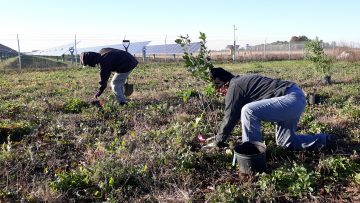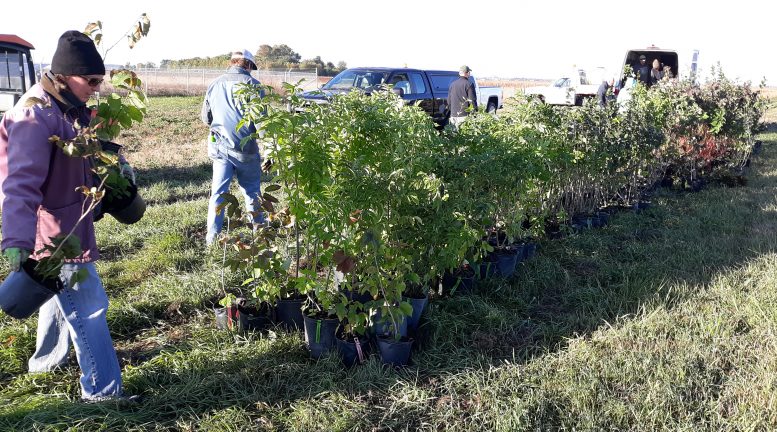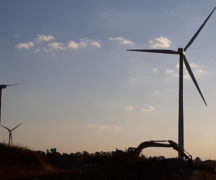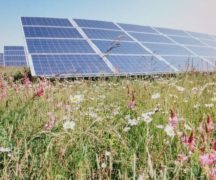By JAN LARSON McLAUGHLIN
BG Independent News
A “solar sanctuary” for butterflies, bees and birds was created Tuesday just north of Bowling Green.
More than 300 shrubs were planted on the north side of the city’s 165-acre solar field near the corner of Newton and Carter roads.
The plants will serve four purposes – attract pollinators, provide food for birds, offer habitat for rabbits and deer, and work on water quality.
The team met Tuesday morning to put the plants in place. Helping with the project was the U.S. Fish & Wildlife Service, the Ohio Division of Wildlife, BGSU students, the City of Bowling Green, and volunteers.
The deep-rooted native plants included serviceberry bushes, hazelnut, dogwood, hawthorn, winterberry, plum, buttonbush and elderberry bushes.
“These are all native plants – host plants with nectar,” to attract native pollinators like Monarch butterflies and bees, said Donnie Knight, of the U.S. Fish & Wildlife Service.
The north side of the solar field was completed Tuesday, and more plantings are planned for the south side, Knight said. That will be a total of about 14 acres of “solar sanctuary” for bees, butterflies, birds and bunnies.
Though many solar fields also have wildflowers planted alongside the solar panels, Knight said that isn’t happening at this field, yet.
“We weren’t able to strike an agreement with the power company,” Knight said of Next Era Energy. “We have a lot of examples of that in Ohio. But we couldn’t make it happen here yet.”
Each plant will have a protective wrap around its base to keep rabbits and deer from nibbling away too much.
“The deer will be able to browse the tops,” but not destroy the shrubs, Knight said.
As part of the Great Lakes Restoration Initiative, the project is also designed to help improve water quality, as the planting area filters water heading to the ditch, destined for Lake Erie.
Helping with the planting from the city of Bowling Green were Arborist Grant Jones, Natural Resources Specialist Cinda Stutzman and Sustainability Coordinator Amanda Gamby.

Bushes are planted for “solar sanctuary.”
When workers arrived Tuesday morning, the 300-plus holes had already been dug along the northern edge of the solar field.
“It’s just a matter of plant, cover and go,” Stutzman said.
Stutzman said the plants should provide habitat for pollinators.
“We know a lot of the pollinators have been in decline,” she said. “Especially the native ones are hurting.”
Last year, Marci Lininger, of the U.S. Fish & Wildlife Service, explained the value of the program to city officials.
“You are producing good clean energy, and you’re helping wildlife at the same time,” Lininger said.
“Pollinators are in decline right now,” she said. Adult Monarch butterflies have seen a 50 percent drop in the last 10 years due to disappearing milkweed plants – which are the only plants used by Monarchs for laying eggs.
Some wildflower habitats target specific species. The one at Bowling Green’s solar site will be aimed at attracting several species of bees, birds and butterflies. The plan calls for three seasons of blooming plants.
Ohio is a priority location for Monarchs on their annual trek to Mexico. “We have a huge responsibility here in Ohio,” Lininger said.
This region also has many crops that are suffering from inadequate pollination, she said. Crops relying on pollination include tomatoes, blueberries, melons, soybeans, peppers, peaches, cucumbers, squash and apples.
Honey bees account for more than $15 billion in agricultural production of fruits, vegetables and nuts, Lininger said.
Water and soil quality are also helped by the wildflower habitats because the native plants have deeper root systems and add nitrogen to the soil. The plants also attract insects, which are a food staple for many birds, and provide bird nesting areas in tall grasses.
The Wood County Park District has agreed to play a role in a local sanctuary for butterflies, bees and birds, by maintaining the planted area.





